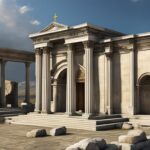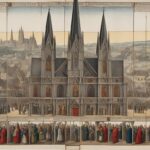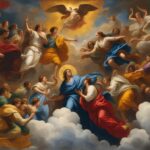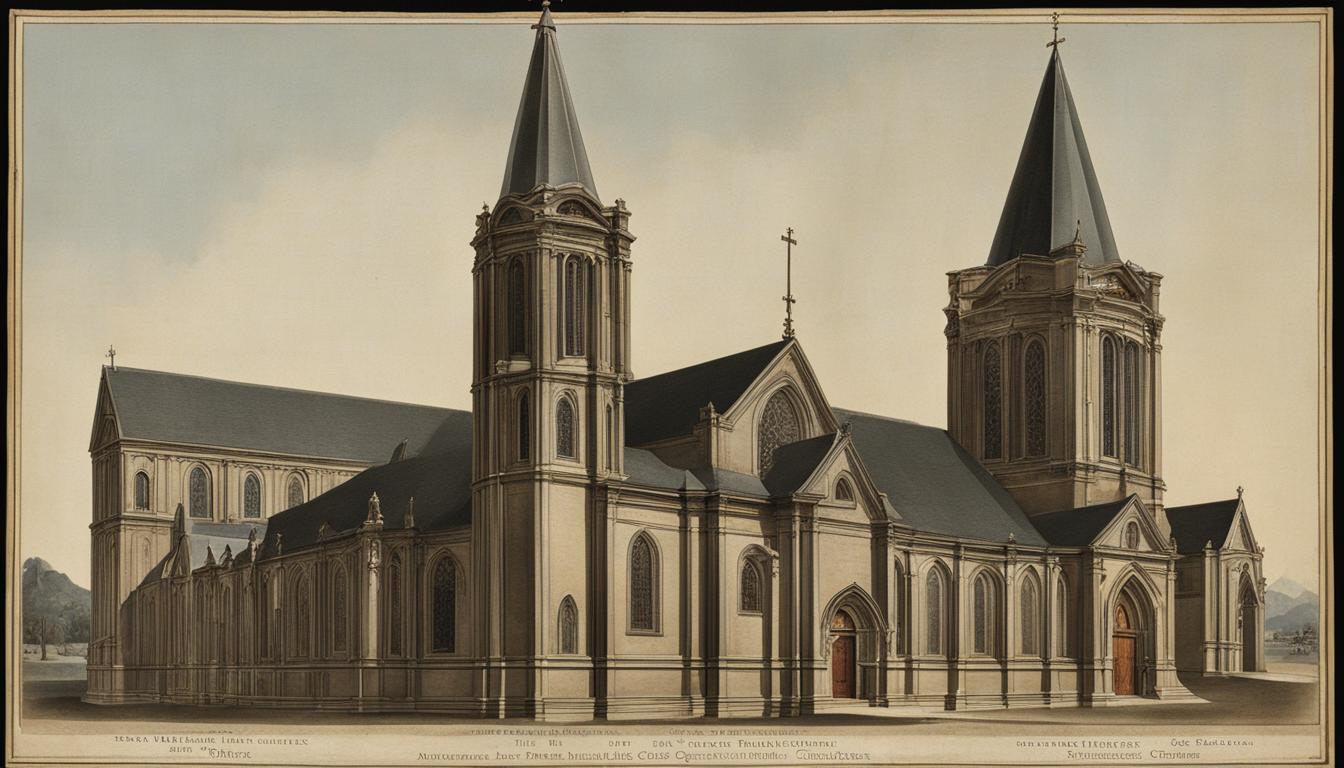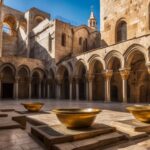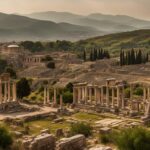Welcome to our guided tour of the historic Church in Pergamum. Situated in the ancient city of Pergamum, this church holds great biblical significance and offers a window into the rich history of ancient worship. Let us delve into the origins, beliefs, practices, and impact of this noteworthy religious institution.
Key Takeaways:
- The Church in Pergamum played a major role in early Christianity and was a significant center of the Christian faith during the Roman Empire.
- It was one of the Seven Churches of Revelation, mentioned in the Book of Revelation.
- The church adhered to the core beliefs and doctrines of the Christian faith, emphasizing faith, love, and obedience to the word of God.
- Although there is no specific information about denominational splits or schisms, the church faced challenges and unique spiritual conditions.
- The governance of the church was based on the principles and instructions found in the Bible, led by elders or overseers.
Origins and Founders of the Church in Pergamum
The Church in Pergamum has its origins in the early Christian era. It was one of the seven churches specifically addressed in the letters written by the Apostle John in the Book of Revelation. The church was founded by early Christian believers in the city of Pergamum, who played a crucial role in spreading the Christian faith in the region.
Pergamum, known for its ancient worship practices, became a significant center of the Christian faith during the Roman Empire. The city’s strategic location and cultural influence contributed to the establishment and growth of the Church in Pergamum. The teachings of the Apostle John laid a foundation for the Christian community in this region, shaping their beliefs and practices.
The Church in Pergamum emerged as a result of the dedication and commitment of these early believers. Their faith in Jesus Christ and their desire to follow His teachings led to the establishment of a vibrant Christian community in Pergamum. The influence of the Apostle John and the dedication of these early founders played a pivotal role in shaping the identity and mission of the Church in Pergamum.
| Origins and Founders of the Church in Pergamum | |
|---|---|
| Origins | Early Christian era |
| Founders | Early Christian believers in Pergamum |
| Role | Spread the Christian faith in the region |
| Influence | Teachings of the Apostle John and dedication of the early founders |
Key Beliefs and Doctrines of the Church in Pergamum
The Church in Pergamum, as a part of the early Christian community, held steadfast to the core beliefs and doctrines of the Christian faith. Their teachings and practices were rooted in the life and teachings of Jesus Christ, as outlined in the Bible. Here are some key beliefs and doctrines that were central to the Church in Pergamum:
- Jesus as the Son of God: The Church in Pergamum believed in the divinity of Jesus Christ, viewing Him as the Son of God and the Messiah who came to save humanity.
- Biblical Authority: The church placed a strong emphasis on the authority and teachings of the Bible. They believed that the Scriptures were inspired by God and served as the ultimate guide for faith and practice.
- Salvation through Faith: Like other Christian communities, the Church in Pergamum believed in salvation through faith in Jesus Christ. They understood that salvation could not be earned through good works alone but required a personal relationship with Christ.
- Love and Unity: The church emphasized the importance of love and unity within the Christian community. They recognized that love was a powerful expression of their faith and played a vital role in their relationships with fellow believers.
- The Second Coming of Christ: The Church in Pergamum, like other early Christian communities, eagerly anticipated the return of Jesus Christ. They believed in the future judgment and the establishment of God’s kingdom on earth.
The Church in Pergamum faced specific challenges and spiritual conditions, as highlighted in the letters addressed to them in the Book of Revelation. These letters served as a call to repentance and a reaffirmation of their commitment to the Christian faith.
Table: Comparison of Key Beliefs and Doctrines
| Beliefs | Church in Pergamum | Modern Christianity |
|---|---|---|
| Jesus as the Son of God | Believed in the divinity of Jesus Christ | Believe in the divinity of Jesus Christ |
| Biblical Authority | Emphasized the authority of the Bible | Emphasize the authority of the Bible |
| Salvation through Faith | Believed in salvation through faith in Jesus Christ | Believe in salvation through faith in Jesus Christ |
| Love and Unity | Emphasized the importance of love and unity | Emphasize the importance of love and unity |
| The Second Coming of Christ | Eagerly anticipated the return of Jesus Christ | Eagerly anticipate the return of Jesus Christ |
Although the Church in Pergamum is no longer active, its commitment to these key beliefs and doctrines continues to shape modern Christianity. The lessons learned from their experiences provide valuable insights for believers today, reminding them of the foundational principles that guide the Christian faith.
Historical Significance of the Church in Pergamum
The Church in Pergamum holds immense historical significance as one of the Seven Churches of Revelation. Located in the ancient city of Pergamum, it played a pivotal role in the development and spread of the Christian faith during the Roman Empire. This historical church served as a center of worship and a beacon of hope for early Christians in the region.
The city of Pergamum itself was renowned for its rich cultural heritage and architectural marvels. It boasted impressive structures such as the Altar of Zeus and the hillside theater. Amidst these grand monuments, the Church in Pergamum stood as a testament to the growing influence of Christianity in the ancient world.
One of the notable aspects of the Church in Pergamum was its biblical significance. The Book of Revelation specifically mentioned the church, addressing its unique challenges and spiritual conditions. This recognition in the sacred text has contributed to the church’s lasting impact on Christian history and its continued study by scholars and historians.
The Historical Significance of the Church in Pergamum
The Church in Pergamum holds immense historical significance as one of the Seven Churches of Revelation. Located in the ancient city of Pergamum, it played a pivotal role in the development and spread of the Christian faith during the Roman Empire. This historical church served as a center of worship and a beacon of hope for early Christians in the region.
The city of Pergamum itself was renowned for its rich cultural heritage and architectural marvels. It boasted impressive structures such as the Altar of Zeus and the hillside theater. Amidst these grand monuments, the Church in Pergamum stood as a testament to the growing influence of Christianity in the ancient world.
One of the notable aspects of the Church in Pergamum was its biblical significance. The Book of Revelation specifically mentioned the church, addressing its unique challenges and spiritual conditions. This recognition in the sacred text has contributed to the church’s lasting impact on Christian history and its continued study by scholars and historians.
Historical Significance of the Church in Pergamum
The Church in Pergamum is historically significant as one of the Seven Churches of Revelation, mentioned in the Book of Revelation. Situated in the ancient city of Pergamum, it played a crucial role in the expansion of Christianity during the Roman Empire. This historic church was a center of worship and a stronghold of the Christian faith.
Pergamum itself was a city of great cultural and architectural significance. It housed extraordinary structures such as the Altar of Zeus and the hillside theater. In the midst of these grand monuments, the Church in Pergamum stood as a symbol of the growing influence of Christianity in the ancient world. Its presence contributed to the religious and cultural history of the city.
Additionally, the biblical significance of the Church in Pergamum is noteworthy. The Book of Revelation addresses the challenges and spiritual conditions faced by the church, emphasizing its importance in early Christian communities. This recognition in sacred scripture has ensured the church’s enduring relevance and the continued study of its historical impact.
| Historical Significance of the Church in Pergamum |
|---|
| The Church in Pergamum is historically significant as one of the Seven Churches of Revelation, mentioned in the Book of Revelation. Situated in the ancient city of Pergamum, it played a crucial role in the expansion of Christianity during the Roman Empire. This historic church was a center of worship and a stronghold of the Christian faith. |
| Pergamum itself was a city of great cultural and architectural significance. It housed extraordinary structures such as the Altar of Zeus and the hillside theater. In the midst of these grand monuments, the Church in Pergamum stood as a symbol of the growing influence of Christianity in the ancient world. Its presence contributed to the religious and cultural history of the city. |
| Additionally, the biblical significance of the Church in Pergamum is noteworthy. The Book of Revelation addresses the challenges and spiritual conditions faced by the church, emphasizing its importance in early Christian communities. This recognition in sacred scripture has ensured the church’s enduring relevance and the continued study of its historical impact. |
Denominational Split or Schisms in the Church in Pergamum
While the Church in Pergamum faced various challenges and spiritual conditions, there is no specific information available regarding denominational splits or schisms within the religious community. The letters addressed to the Church in Pergamum in the Book of Revelation highlight the struggles they encountered, such as the presence of false teachings and the influence of Pagan practices, but there is no direct mention of internal divisions.
It is important to note that during the early years of Christianity, different churches and communities had their own unique circumstances and experiences. It is possible that the Church in Pergamum may have faced internal disagreements or disputes, but these details are not explicitly mentioned in historical records.
Despite the lack of information on denominational splits or schisms, the Church in Pergamum played a significant role in early Christianity and its contributions to the development of the Christian faith remain notable.

Leadership and Governance of the Church in Pergamum
The Church in Pergamum had a well-defined leadership structure to ensure the spiritual guidance and growth of its members. The early Christian community in Pergamum was overseen by a group of elders or overseers who were responsible for the governance of the church. These leaders were chosen based on their maturity in faith, wisdom, and their ability to shepherd the believers in accordance with the teachings of Jesus Christ.
The governance of the church was based on the principles and instructions found in the Bible, which served as the ultimate authority and guide for the early Christian community. The elders were entrusted with the task of teaching and upholding the core beliefs and doctrines of the Christian faith among the believers. They provided pastoral care, resolved conflicts, and ensured the proper administration of the church’s activities.
The leadership and governance structure of the Church in Pergamum reflected the importance of unity and accountability within the community. It fostered a sense of order, mutual respect, and shared responsibility among the believers. Through their leadership, the elders played a vital role in nurturing the spiritual well-being of the church and preserving the integrity of the Christian faith.
Table: Roles and Responsibilities of Church Elders
| Role | Responsibilities |
|---|---|
| Shepherding | Providing spiritual guidance, counseling, and support to the congregation. |
| Teaching | Instructing the believers in the principles of the Christian faith and Biblical teachings. |
| Leadership | Overseeing the church’s activities and decision-making processes. |
| Pastoral Care | Caring for the needs of the congregation, including visitation, prayer, and support during times of difficulty. |
| Discipline | Ensuring the adherence to Christian principles and addressing any issues or conflicts within the church community. |
| Administration | Managing the resources and finances of the church to support its mission and ministry. |
Worship Practices of the Church in Pergamum
The Church in Pergamum, like other early Christian communities, had well-defined worship practices that were deeply rooted in ancient traditions and carried significant biblical significance. These practices were aimed at fostering spiritual growth, nurturing the believers’ relationship with God, and strengthening the bonds of the community.
Regular Worship Services
The church congregated regularly to participate in worship services. These gatherings provided an opportunity for the believers to come together, offer prayers, and seek guidance and blessings from the Lord. The services were conducted in a reverent and solemn manner, reflecting the deep devotion and faith of the worshippers.
Scripture Reading and Teaching
The Church in Pergamum placed great emphasis on the reading and teaching of the Scriptures. The believers gathered to listen to the teachings of the early Christian leaders, who expounded on the word of God and its application to their lives. The Bible played a central role in guiding their beliefs, actions, and moral conduct.
Celebration of Sacraments
The sacraments of baptism and communion were integral parts of the worship practices in the Church in Pergamum. Baptism symbolized the believers’ commitment to their faith and their initiation into the Christian community. Communion, also known as the Lord’s Supper, was a sacred ceremony commemorating the sacrifice of Jesus Christ and signifying the believers’ unity with Him and with one another.
| Worship Practices of the Church in Pergamum | Biblical Significance |
|---|---|
| Regular Worship Services | Provides an opportunity for believers to come together, offer prayers, and seek guidance and blessings from the Lord. |
| Scripture Reading and Teaching | Emphasizes the importance of the Bible as a guiding force in shaping beliefs, actions, and moral conduct. |
| Celebration of Sacraments | Symbolizes the believers’ commitment to their faith, unity with Christ, and unity with the Christian community. |
The worship practices of the Church in Pergamum served as a source of spiritual nourishment, community bonding, and guidance for the early Christian believers. These practices continue to inspire and shape the worship traditions of modern-day Christian communities, showcasing the enduring legacy of the Church in Pergamum.

“The Church in Pergamum held worship services where the believers gathered in reverence to offer prayers and seek guidance from the Lord. The reading and teaching of the Scriptures were central to their worship, emphasizing the importance of the Bible in shaping their beliefs and moral conduct. The celebration of sacraments, such as baptism and communion, symbolized the believers’ commitment to their faith and their unity with Christ and the Christian community.”
Contemporary Influence of the Church in Pergamum
The Church in Pergamum, although no longer in existence as an active contemporary institution, continues to exert a profound influence in the realm of Christian history. As one of the Seven Churches of Revelation, its historical significance cannot be understated. Scholars and historians recognize the enduring impact it had on the development and spread of Christianity during the Roman Empire.
This ancient church served as a spiritual center and played a crucial role in the early Christian community. The teachings, beliefs, and experiences of the Church in Pergamum serve as a fountain of knowledge and inspiration for modern-day believers. Its legacy provides invaluable insights into the challenges faced by early Christians and their unwavering commitment to their faith.
Today, the Church in Pergamum serves as a reminder of the endurance and resilience of the Christian faith. It gives us a glimpse into the origins of Christianity and the transformative power it had on the lives of believers. The lessons learned from the Church in Pergamum continue to shape the way we practice and understand our faith in contemporary society.

As we explore the historical church in Pergamum, we gain a deeper appreciation for the cultural and biblical significance it holds. The Church in Pergamum strengthens our connection to the roots of Christianity and provides a solid foundation for our continued spiritual growth. Although the church may no longer stand, its influence and impact continue to resonate in the hearts and minds of believers across the globe.
Current World Membership Number and Percentage of World Religions
The Church in Pergamum, being an ancient church, does not have current membership numbers. As an early Christian community, its membership would have been limited to the local population in the city of Pergamum and surrounding areas. However, it is important to note that Christianity, as a global religion, has experienced significant growth over the centuries.
Today, Christianity is the largest religion in the world, with an estimated 2.3 billion adherents, representing approximately 31% of the global population. This includes various denominations and branches of Christianity spread across different countries and continents. While the Church in Pergamum no longer exists as an active institution, its historical significance contributes to the overall narrative and development of Christianity as a whole.
It is worth mentioning that Christianity is followed by different denominations and sects, each with their own membership numbers and regional distributions. Some of the major Christian denominations include Roman Catholicism, Eastern Orthodoxy, and various Protestant denominations. The global membership numbers for each denomination can vary widely, with some having hundreds of millions of adherents, while others have smaller congregations.
| Religion | Membership Number | Percentage of World Population |
|---|---|---|
| Christianity | 2.3 billion | 31% |
| Islam | 1.9 billion | 24.9% |
| Hinduism | 1.2 billion | 15.6% |
| Buddhism | 535 million | 7% |
| Judaism | 15 million | 0.2% |
| Other Religions | 1.2 billion | 16.3% |
| No Religion/Atheism | 1.2 billion | 16.3% |
Note: The membership numbers and percentage of world population shown in the table are approximate and can vary based on different sources and methodologies used for data collection. These figures are meant to provide a general overview and should not be considered as exact or definitive.
Conclusion
The Church in Pergamum holds a significant place in Christian history as one of the Seven Churches of Revelation. Its rich heritage and ancient worship practices have left an indelible mark on the development of the Christian faith. The church, founded by early believers in Pergamum, played a crucial role in spreading Christianity during the Roman Empire.
The Church in Pergamum’s key beliefs and adherence to biblical doctrines shaped the spiritual journey of its members. They valued faith, love, and obedience to the word of God as they faced the specific challenges of their community. This historical church’s presence in Pergamum contributed to the vibrant religious and cultural tapestry of the ancient city.
While there is no specific information available about denominational splits or schisms within the Church in Pergamum, its leadership and governance structures mirrored those of other early Christian communities. Guided by elders or overseers, the church’s governance was rooted in the teachings of the Bible.
The worship practices of the Church in Pergamum aligned with those of early Christian communities. Regular gatherings for prayers, hymns, Scripture readings, and sacraments deepened believers’ relationship with God. Though the Church in Pergamum is no longer an active institution, its historical significance and impact on Christianity continue to be studied and appreciated by scholars and historians.
FAQ
What is the Church in Pergamum?
The Church in Pergamum was one of the Seven Churches of Revelation mentioned in the Book of Revelation. It was an ancient church located in the city of Pergamum, which played a significant role in early Christianity during the Roman Empire.
Who founded the Church in Pergamum?
The Church in Pergamum was founded by early Christian believers in the city of Pergamum. While specific individuals are not mentioned, they played a crucial role in spreading the Christian faith in the region.
What were the key beliefs of the Church in Pergamum?
The Church in Pergamum adhered to the core beliefs and doctrines of the Christian faith. They embraced the teachings of Jesus Christ and the principles outlined in the Bible. The church valued faith, love, and obedience to the word of God.
What was the historical significance of the Church in Pergamum?
The Church in Pergamum was a major center of Christianity during the Roman Empire and contributed to the spread and development of the Christian faith. Its presence in Pergamum has left a lasting impact on the religious and cultural history of the ancient city.
Were there any denominational splits or schisms in the Church in Pergamum?
There is no specific information available regarding denominational splits or schisms within the Church in Pergamum. The church faced challenges and different spiritual conditions, as mentioned in the Book of Revelation, but there is no direct mention of a denominational split or schisms within the community.
How was the Church in Pergamum governed?
The Church in Pergamum had a leadership and governance structure in place. They were guided by elders or overseers who were responsible for the spiritual well-being of the church and ensuring adherence to Christian teachings. The governance of the church was primarily based on the principles and instructions found in the Bible.
What were the worship practices of the Church in Pergamum?
The Church in Pergamum followed worship practices common to early Christian communities. They congregated for regular worship services, which included prayers, singing hymns, reading and teaching from the Scriptures, and celebrating the sacraments, such as baptism and communion.
Is the Church in Pergamum still active today?
The Church in Pergamum no longer exists as an active, contemporary institution. However, its historical significance and impact on Christianity continue to be recognized and studied by scholars and historians.
What is the current membership number of the Church in Pergamum?
As an ancient church, there is no specific information available regarding the current membership number of the Church in Pergamum.
What is the percentage of world religions attributed specifically to the Church in Pergamum?
It is challenging to determine the percentage of world religions attributed specifically to the Church in Pergamum due to its historical context and the evolution of Christianity over time.





